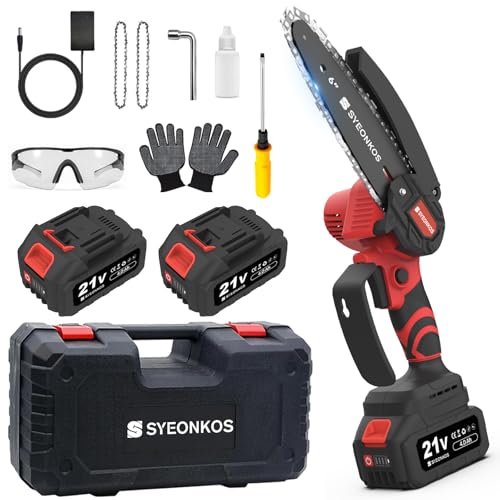Understanding Mini Chainsaws: What They Are and How They Work
What is a Mini Chainsaw?
Mini chainsaws are compact power tools designed for cutting through wood. They work similarly to traditional chainsaws but are smaller, lighter, and easier to handle. These tools are perfect for homeowners, hobbyists, or garden enthusiasts who need a tool for light pruning, trimming branches, or handling small to medium-sized jobs in the yard. Their design allows for greater precision, making them ideal for detailed work, such as shaping shrubs or clearing out dead weight in trees without the bulk and weight of a standard chainsaw.
How Do They Operate?
Operating a mini chainsaw involves using an electric or battery-powered motor that drives a rotating chain with sharp teeth around a metal guide bar. This movement allows the chain to slice through wood with ease. Most mini chainsaws feature a simple trigger mechanism to control speed and power, making them user-friendly even for those who are not familiar with heavy-duty equipment. The electric or battery options eliminate the need for fuel and reduce emissions, providing an eco-friendlier and quieter cutting experience.
Key Features to Look for in a Mini Chainsaw
Size and Weight Considerations
When selecting a mini chainsaw, size and weight are crucial factors. A lighter chainsaw is easier to manoeuvre and reduces fatigue during prolonged use. If you’re planning to use the chainsaw overhead or in tight spaces, opt for a model that enhances portability without sacrificing power. Most mini chainsaws weigh between 2 to 8 kg, making them manageable for most users.
Power Source: Corded vs. Cordless
Consider the power source when choosing your mini chainsaw. Cordless models offer greater flexibility and freedom of movement, as you won’t be tethered to an electrical outlet. They typically use rechargeable batteries, which vary in capacity and run time. In contrast, corded models provide consistent power and are more suited for longer, continuous use; however, they limit your reach to the length of the electrical cord. Evaluate your typical usage environment to see which option best suits your needs.
Safety Features
Safety is paramount when using any power tool. Look for mini chainsaws equipped with important safety features. A chain brake is essential; it stops the chain quickly to prevent accidents. Additional features include hand guards to protect against debris and anti-vibration systems that enhance comfort during use. Such features make your work safer and more enjoyable.
Bar Length and Cutting Capacity
The bar length of a mini chainsaw directly impacts what it can cut. Most mini chainsaws range in bar length from 20 to 40 cm, allowing them to handle branches and logs of various sizes. Choose a length that fits your typical cutting tasks; a longer bar will allow for larger cuts but may be harder to handle for precise work. Assess your normal size requirements to select an appropriate model.
Comparing the Top Mini Chainsaw Models Available on the Market
Popular Models Overview
There are several noteworthy mini chainsaws currently available. Each model has its unique strengths and features designed to suit different user preferences. When comparing models, consider aspects such as battery life, chain speed, ease of chain replacement, and ergonomic design. Some models may offer additional attachments or features that can enhance functionality, such as extendable poles for reaching higher branches.
Real User Feedback
Reading real user feedback can provide insight into the performance and reliability of different mini chainsaw models. Look for reviews that discuss ease of use, durability, and overall satisfaction. This can help you gauge how well a chainsaw performs in practical applications and help you make a more informed decision.
How to Choose the Right Mini Chainsaw for Your Needs
Assess Your Cutting Needs
When choosing a mini chainsaw, start by assessing your cutting needs. Are you primarily using it for light pruning around your garden? Or do you need a tool that can handle larger branches or wood? Identifying the scope of your tasks will influence the features you prioritise, such as power, weight, and bar length.
Evaluate Your Skill Level
Your skill level with power tools can also guide your choice. If you are a novice, look for a model that offers intuitive controls and safety features. Some brands cater specifically to beginner users with simpler setups and ergonomics that reduce the learning curve. More experienced users might prefer additional features that allow for more intricate cutting and adjustments.
Budget Considerations
Budget plays a key role in your purchase decision. Mini chainsaws come at various price points, so determine what you are willing to invest. Remember, while cheaper models may seem appealing, they might lack durability and reliability. Balancing cost with quality will ensure you invest in a tool that meets your needs without constant replacement.
Essential Safety Tips for Using a Mini Chainsaw
Wear Appropriate Safety Gear
Always wear suitable safety gear when operating a mini chainsaw. This includes safety glasses to protect your eyes from flying debris, gloves for grip and hand protection, and sturdy footwear to safeguard your feet. When working with a chainsaw, being prepared is vital for preventing injuries.
Maintain Proper Body Positioning
Proper positioning is crucial while using a mini chainsaw. Stand with your feet apart for better balance, and keep your body to the side of the cutting line. This position protects you from any potential kickback from the tool. Additionally, always be aware of your surroundings to avoid obstacles or hazards.
Learn the Basics of Chain Maintenance
Routine maintenance is also an integral part of safety when using a mini chainsaw. Keep the chain sharp and properly lubricated, as a dull chain can cause excessive stress during cutting, leading to accidents. Familiarise yourself with the specific maintenance requirements for your chosen model to ensure it operates safely and efficiently.



















